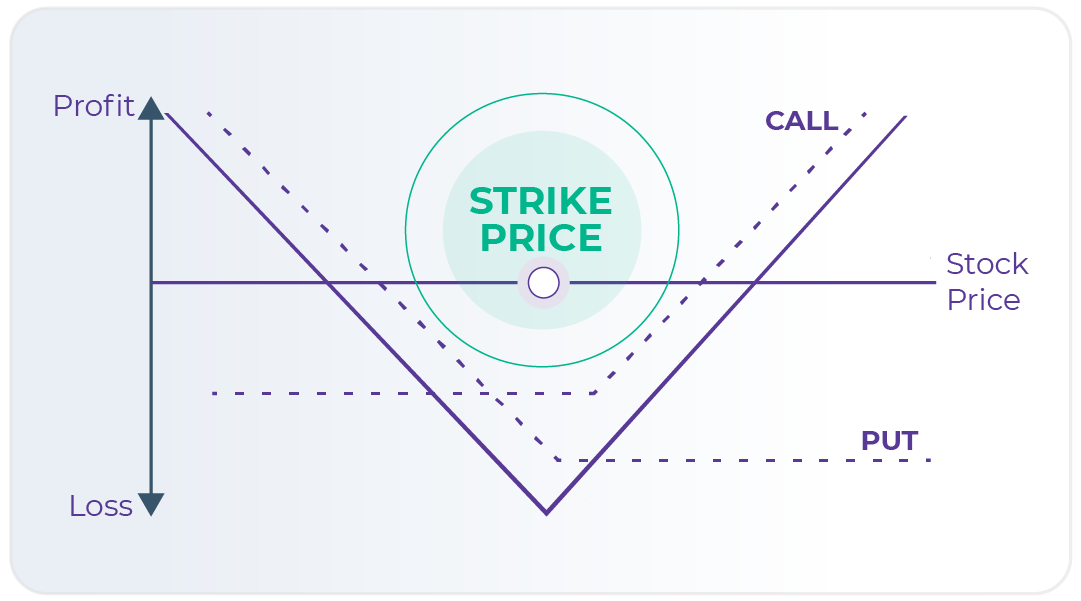A straddle is a strategy that traders typically use when they want to bet on the price of an asset but aren’t sure if it’s likely to go up or down — if they are buying the straddle, or have a high conviction that the price will remain stable — if they sell the straddle. The long straddle allows them to play both sides, so they can profit regardless of which direction the market moves in. On the other hand, if they sell the straddle they will lose money in a sharper directional move either way.
When buying the straddle, the catch is that the market needs to move definitively in one direction or another. If the market doesn’t move at all, the trader risks losing the premiums they’ve paid to put the straddle in place, or vice versa if they sold the straddle.
A straddle typically consists of two options :
- A put option — an option that gives you the right, but not the obligation, to sell the commodity at a pre-agreed price (this is known as the strike price)
- A call option — an option that gives you the right, but not the obligation, to buy the commodity at a pre-agreed strike price
The put option and call option are both for the same asset — in our case, this would be a currency pair. They’d also have the same expiration date, and the same strike price.
The idea is that the two options are identical but opposite. So, depending on which way the market goes, you exercise one option or the other to make a profit. Conversely if you sold the straddle, you will get exercised on one option or the other and make a loss.
Imagine you wanted to speculate on EUR/GBP , but weren’t sure if the Pound will rise against the Euro or the Euro will rise against the Pound.
If you buy straddle, it doesn’t matter, provided the market moves definitively in one direction or another past the break-even point.
- of £50 for it.
- You buy an option to exchange £2,000 for Euro, also at a strike price of GBP/EUR 1.20. Here, you’d get €1.20 for every £1. Like the other option, this also expires on 2 December. The premium you’ve paid for this option is also £50.
Let’s say that, in November, the Euro appreciates against the Pound, and the market exchange rate goes up to GBP/EUR 1.30 Here, you’d lose money if you used your option to exchange Pounds for Euro. This is because you’d get only €1.20 for every £1, whereas on the market £1 is worth €1.30 — 10c more per Pound.
But the option to exchange Euro for Pounds is profitable. At the market rate, £1 costs €1.30, whereas at your option rate £1 only costs €1.20. So while, on the market, €2,000 would buy you £1,538, exercising your option would get you £1,567 (£1,667 less the £100 in premiums you’ve paid to buy both options).
Conversely, if the Pound appreciated against the Euro and the market exchange rate went down to GBP/EUR 1.10, you’d ignore the option to exchange Euro for Pounds and make a profit using your Pounds for Euro option.
What if the market is quiet?
Here’s how it would work:
- You buy an option to exchange €2,000 for Pounds at a strike price of GBP/EUR 1.20. This means you’ll get £1 for every €1.20. The option expires on 2 December and you’ve paid a premium
A unique feature of market-neutral options strategies — and straddles in particular — is that you can also profit when the market is relatively quiet. To do this, instead of buying two identical but opposite options — this is known as a long straddle — you’d sell two identical but opposite options.
The latter type of straddle is known as a short straddle. Here, you profit from the premium you sell the options for, not from big changes in the underlying commodity’s value.

Some Facts
- A straddle is known as a ‘neutral’ option because you don’t have to commit to a particular outcome. The way it’s structured allows you to benefit both if the price goes up and if it goes down when you own the straddle. Of course, the market needs to move enough in either direction for you to recoup the premiums you’ve paid for both options.
- Straddle trades are most effective when the market is expecting big news — for example, a country’s central bank is teasing an important policy announcement. Big news usually means big price fluctuations and, so, the potential for big profits. The price of a straddle fluctuates as the market digests news that may influence the outcome of a bit event such as a central bank decision.
Want to know more?
- This series of short videos explains short straddles, long straddles, and six other types of neutral options strategies.
- The opposite of a straddle is a strangle — a call option and a put option that have different strike prices, instead of the same strike price. This article explains the key differences between a straddle and a strangle and explains when you’d choose one or the other.
ALT21’s perspective:
‘The straddle is a good technique to have in your back pocket in times when the market is volatile because, as long as the market moves enough in one direction or the other, you may be able to benefit. But a straddle isn’t just for speculating… if your business is exposed to exchange rate fluctuations and things are looking very uncertain, hedging using the straddle technique can help you protect yourself from an unpredictable market swing in either direction.’


